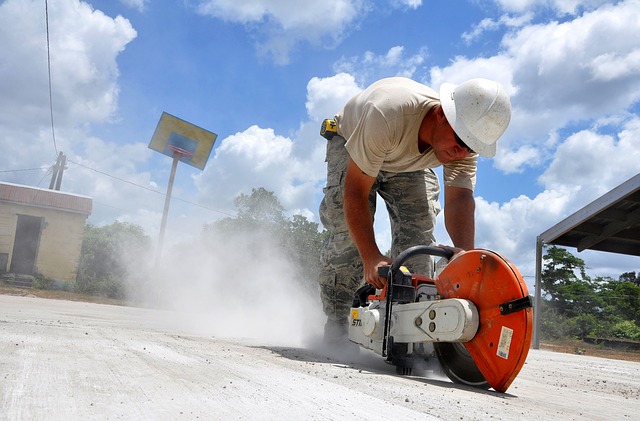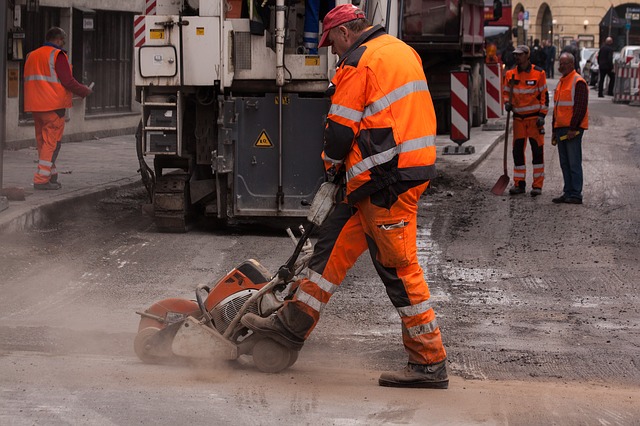Construction dust
Contents |
[edit] Introduction
The glossary of statistical terms, published by the Organisation for Economic Co-operation and Development (OECD), defines dust as: ‘…particles light enough to be suspended in air.’
Construction dust includes a number of different types of dusts that are commonly generated on construction sites. They can be dirty and cause nuisance, but can also be seriously damaging to health, sometimes with long-term implications.
Construction workers have a particularly high risk of developing health problems as a result of prolonged exposure to high levels of dust. The Health and Safety Executive (HSE) estimate that more than 500 construction workers a year are believed to die from exposure to silica dust.
There are many routine tasks on a construction site that are capable of producing high levels of dust:
- Cutting paving blocks, kerbs and flags.
- Chasing concrete and raking mortar.
- Dry sweeping site areas.
- Cutting roofing tiles.
- Scabbling or grinding concrete or other construction materials.
- Soft strip demolition.
- Cutting and sanding wood.
- Sanding taped and covered plasterboard joints.
The Control of Substances Hazardous to Health Regulations 2002 (COSHH) regulate activities that may expose workers to construction dust. It provides a legal duty for employers to prevent or adequately control worker exposure, and requires that risks are assessed and controlled and that controls are reviewed.
[edit] Types of dust
The three main types of dust encountered on construction sites are:
- Silica dust: Created when working on materials that contain silica, such as concrete, mortar and sandstone. Also referred to as Respirable crystalline silica (RCS).
- Wood dust: Created when working on softwood, hardwood, and wood-based products such as MDF and plywood.
- Lower toxicity dusts: Created when working on materials containing little-to-no silica, such as gypsum (in plasterboard), limestone, dolomite and marble.
[edit] Health risks
Dust builds up in the lungs and while the effects may not immediately be obvious, over a prolonged period of time, exposure to high levels of dust can lead to permanent damage to the lungs and airways. Some of the dust-related diseases that most affect construction workers include:
- Lung cancer.
- Silicosis.
- Chronic obstructive pulmonary disease (COPD).
- Asthma.
[edit] Nuisance
Construction dust is a potential cause of nuisance to neighbours.
Reasonable precautions that might be taken to reduce or avoid nuisance in construction might include:
- Keeping neighbours informed.
- Providing a help line so that problems can be reported.
- Storing fine materials under cover.
- Damping fine materials and roadways.
- Minimising demolition or crushing dust.
- Washing down vehicles.
- Taking care when deciding transport routes.
- Providing hard-surfaced roadways.
- Proper waste management.
- Using well-maintained machinery.
- Careful sub-contractor management.
[edit] Assessing the risks
There are a number of factors that will contribute to risks from dust:
- Risk is increased with the more energy that the work involves. High-energy tools like cut-off saws, grinders and grit blasters produce a lot of dust in a very short time.
- Dust will build up depending on how enclosed with working area is.
- The longer the work takes the more dust there will be.
- Risks are increased by regularly doing the same work day after day.
It is important that workers are made aware of the risks from dust and how it can harm their health. They must be fully-trained and informed how to use dust control measures that have been put in place, how to maintain equipment, and how to use and look after respiratory protective equipment (RPE).
[edit] Controlling the risks
[edit] Prevention or reduction of dust
Methods for preventing or reducing dust levels should be assessed prior to work beginning. Measures could include:
- Using building materials that do not require an excessive amount of preparatory cutting to size.
- Silica-free abrasives to reduce risk when blasting.
- Using less-powerful tools, such as a block splitter instead of a higher energy cut-off saw.
- Adopting a different working method, such as direct fastening/screws, or hand-cutting roof tiles.
[edit] Controlling dust levels
There are two main methods for controlling the level of dust that gets into the air:
- Water suppression: Water helps to damp down clouds of dust. Care must be taken to use the right level of water for the whole duration of the work.
- On-tool extraction: Local exhaust ventilation (LEV) systems can be fitted directly onto tools and works to remove dust as it is produced.
[edit] Respiratory protective equipment (RPE)
Preventative and control measures may not always be sufficient, making protective equipment such as powered face masks necessary. Different types of RPE are given an assigned protection factor (APF) which indicates the level of protection it provides. An APF of 20 is the general level for construction dust, which means that the wearer breathes only one-twentieth of the amount of dust in the air.
The RPE must be suitable and comfortable for the work, compatible with other items of protective equipment, and should be worn correctly by the worker.
For more information, see Fit testing.
[edit] Other controls
These prevention and control techniques may need to be used in combination with other controls, such as:
- Keeping the number of workers near the dust-producing work area to a minimum.
- Using sheeting and temporary screens to enclose the work area.
- Using general mechanical ventilation to remove dust-filled air from the work area.
- Rotating workers working on the dust-producing activity.
[edit] Reviewing the controls
It is important that as well as assessing the risks and putting controls in place, regular reviews are held to ensure that they are working correctly. Procedures should be put in place to ensure that dust-producing work is being done correctly and in the safest possible way.
Equipment must be maintained appropriately, with RPE filters changed regularly. A thorough examination and test of any on-tool extraction system should be carried out at least every 14 months.
Workers should be involved by consulting them on any problems and solutions that could be introduced. They should also be supervised to ensure they are using the provided controls and the correct work method.
[edit] Related articles on Designing Buildings
- Achieve safety in demolition.
- Air quality.
- Asbestos.
- BREEAM Monitoring of Construction Site Impacts.
- Construction health risks.
- Control of Substances Hazardous to Health (COSHH).
- Deleterious materials.
- Demolition.
- Disamenity dust.
- Dust control systems.
- Environmental health.
- Filtering facepieces.
- Fugitive dust.
- Hazardous substances.
- Inspections focus on occupational lung disease.
- Nuisance in construction.
- Occupational health.
- Personal protective equipment.
- Pollution.
- Reporting accidents and injuries on construction sites.
- Sanding.
- Silica.
- The dust control systems market.
- The impact of silicosis on the construction industry.
- TSI Environmental dust monitoring system.
[edit] External resources
Featured articles and news
Infrastructure that connect the physical and digital domains.
Harnessing robotics and AI in challenging environments
The key to nuclear decommissioning and fusion engineering.
BSRIA announces Lisa Ashworth as new CEO
Tasked with furthering BSRIA’s impressive growth ambitions.
Public buildings get half a million energy efficiency boost
£557 million to switch to cleaner heating and save on energy.
CIOB launches pre-election manifesto
Outlining potential future policies for the next government.
Grenfell Tower Inquiry announcement
Phase 2 hearings come to a close and the final report due in September.
Progress from Parts L, F and O: A whitepaper, one year on.
A replicated study to understand the opinion of practitioners.
ECA announces new president 2024
Electrical engineer and business leader Stuart Smith.
A distinct type of countryside that should be celebrated.
Should Part O be extended to existing buildings?
EAC brands heatwave adaptation a missed opportunity.
Definition of Statutory in workplace and facilities management
Established by IWFM, BESA, CIBSE and BSRIA.
Tackling the transition from traditional heating systems
59% lack the necessary information and confidence to switch.
The general election and the construction industry
As PM, Rishi Sunak announces July 4 date for an election.
Eco apprenticeships continue help grow green workforce
A year after being recognised at the King's coronation.
Permitted development rights for agricultural buildings
The changes coming into effect as of May 21, 2024.
























Comments
[edit] To make a comment about this article, click 'Add a comment' above. Separate your comments from any existing comments by inserting a horizontal line.